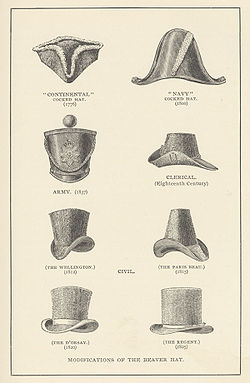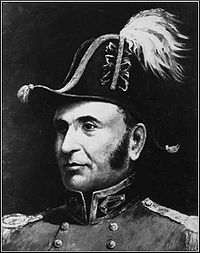
Beaver hat
Encyclopedia



Felt
Felt is a non-woven cloth that is produced by matting, condensing and pressing woollen fibres. While some types of felt are very soft, some are tough enough to form construction materials. Felt can be of any colour, and made into any shape or size....
ed beaver
Beaver
The beaver is a primarily nocturnal, large, semi-aquatic rodent. Castor includes two extant species, North American Beaver and Eurasian Beaver . Beavers are known for building dams, canals, and lodges . They are the second-largest rodent in the world...
fur. They were fashionable across much of Europe
Europe
Europe is, by convention, one of the world's seven continents. Comprising the westernmost peninsula of Eurasia, Europe is generally 'divided' from Asia to its east by the watershed divides of the Ural and Caucasus Mountains, the Ural River, the Caspian and Black Seas, and the waterways connecting...
during the period 1550-1850 because the soft yet resilient material could be easily combed to make a variety of hat shapes (including the familiar top hat
Top hat
A top hat, beaver hat, high hat silk hat, cylinder hat, chimney pot hat or stove pipe hat is a tall, flat-crowned, broad-brimmed hat, predominantly worn from the latter part of the 18th to the middle of the 20th century...
). Emperor Norton I wore a beaver hat decorated with a peacock feather and rosette.
The demand for beaver pelts
Fur
Fur is a synonym for hair, used more in reference to non-human animals, usually mammals; particularly those with extensives body hair coverage. The term is sometimes used to refer to the body hair of an animal as a complete coat, also known as the "pelage". Fur is also used to refer to animal...
in Europe ultimately drove the animal to near-extinction
Extinction
In biology and ecology, extinction is the end of an organism or of a group of organisms , normally a species. The moment of extinction is generally considered to be the death of the last individual of the species, although the capacity to breed and recover may have been lost before this point...
. Its popularity contributed to the dwindling of the population of the animal in the New World
New World
The New World is one of the names used for the Western Hemisphere, specifically America and sometimes Oceania . The term originated in the late 15th century, when America had been recently discovered by European explorers, expanding the geographical horizon of the people of the European middle...
and fuelled colonial expansion as more people sought the fortunes of the trade.
In 1624 (the year New York
New York
New York is a state in the Northeastern region of the United States. It is the nation's third most populous state. New York is bordered by New Jersey and Pennsylvania to the south, and by Connecticut, Massachusetts and Vermont to the east...
was first settled) Dutch
Netherlands
The Netherlands is a constituent country of the Kingdom of the Netherlands, located mainly in North-West Europe and with several islands in the Caribbean. Mainland Netherlands borders the North Sea to the north and west, Belgium to the south, and Germany to the east, and shares maritime borders...
settlers were recorded having shipped 1500 beaver and 500 otter
Otter
The Otters are twelve species of semi-aquatic mammals which feed on fish and shellfish, and also other invertebrates, amphibians, birds and small mammals....
skins to Europe.
Used winter coats worn by Native Americans
Native Americans in the United States
Native Americans in the United States are the indigenous peoples in North America within the boundaries of the present-day continental United States, parts of Alaska, and the island state of Hawaii. They are composed of numerous, distinct tribes, states, and ethnic groups, many of which survive as...
were actually a prized commodity for hat making
Hatter
A hatter is a person engaged in hatmaking.Hatter also may refer to:*The Hatter, a fictional character in Alice's Adventures in Wonderland* Luton Town F.C., team a.k.a. "The Hatters"* Stockport County F.C., team a.k.a. "The Hatters"...
because their wear helped prepare the skins; separating out the coarser hairs from the pelts.
The busy trade in beaver pelts was a fundamental factor in the exploration and early settlement of Canada. The Hudson's Bay Company
Hudson's Bay Company
The Hudson's Bay Company , abbreviated HBC, or "The Bay" is the oldest commercial corporation in North America and one of the oldest in the world. A fur trading business for much of its existence, today Hudson's Bay Company owns and operates retail stores throughout Canada...
, which was founded in the early 17th century and is still in existence, made its fortune through this trade. For its role in Canada's early economic development, the beaver has been honoured with a depiction on the Nickel (Canadian coin)
Nickel (Canadian coin)
The Canadian five-cent coin, commonly called a nickel, is a coin worth five cents or one-twentieth of a Canadian dollar. It was patterned on the corresponding coin in the neighbouring United States...
.
To make felt, the underhairs were shaved from the beaver pelt and mixed with a vibrating hatter's bow. The matted fabric was pummeled and boiled repeatedly, resulting in a shrunken and thickened felt. Filled over a hat-form block, the felt was pressed and steamed into shape. The hat maker then brushed the outside surface to a sheen. Beaver hats were made in various styles as a matter of civil status: the wellington (1820–40), the paris beau (1815), the d'orsay (1820), the regent (1825) and the clerical (18th century). In addition, beaver hats were made in various styles as a matter of military status: the continental cocked hat (1776), Navy cocked hat (19th century), and the Army shako (1837).
The popularity of the beaver hat declined in the early/mid-19th century as silk hats
Top hat
A top hat, beaver hat, high hat silk hat, cylinder hat, chimney pot hat or stove pipe hat is a tall, flat-crowned, broad-brimmed hat, predominantly worn from the latter part of the 18th to the middle of the 20th century...
became vogue.

